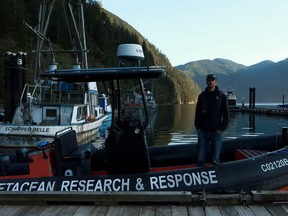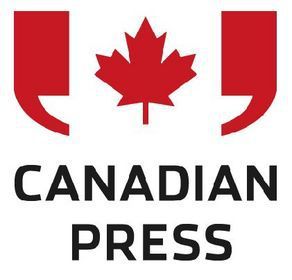“I think there’s a really good chance she can make it,” said marine scientist Jared Towers

Article content
ZEBALLOS — The odds of a two-year old killer whale calf surviving in the open ocean on its own and eventually reuniting with family members remain solid if a rescue team manages to free the orca from the Vancouver Island lagoon where she’s been trapped for nearly a month, whale experts say.
A second attempt to rescue the orca was put on hold Friday when the young whale ate an 18-kilogram portion of provided seal meat for what was believed to be the first time since getting stranded in the tidal lagoon in Little Espinosa Inlet near Zeballos. The large-scale rescue effort is expected to involve boats, nets, divers and drones and centres on a plan to catch the female calf in a large net, place her in a sling, transport her to the nearby ocean and release her.
Advertisement 2
Article content
Article content
The video confirmation of the orca calf eating the seal meat gave the rescue team, comprised of Indigenous leaders, federal Fisheries Department specialists and fishing experts, more time to consider their options.
“I think there’s a really good chance she can make it,” said marine scientist Jared Towers, who has been working with the rescue team since March 23 when the calf became trapped alone after the death of her pregnant mother.
“She’s proved very resilient here in the three-and-a-half weeks that we’ve known her to be stuck in the inlet,” he said. “She’s pretty healthy considering she hasn’t eaten a lot during that time. She’s behaving like a killer whale. She’s calling. She’s broadcasting that she’s around and that’s really what it’s going to take for her to connect with other whales.”
Towers, who studies the movements, behaviour and abundance of west coast B.C. whales with Bay Cetology, said he spotted Gray whales Friday in ocean waters near Zeballos, located more than 450 kilometres northwest of Victoria. But there was no recent sign of killer whales that may be related to the trapped calf.
Article content
Advertisement 3
Article content
The last confirmed sighting of members of the young orca’s pod was more than two weeks ago in the Barkley Sound area south of Zeballos and near Port Alberni, he said.
The calf, about three metres long and estimated to weigh about 700 kilograms, has been named kwiisahi?is, or Brave Little Hunter by the local Ehattesaht First Nation.
“This population is called Bigg’s killer whales, they’re transient killer whales and there’s several families and the T109 lineage includes 24 living members now, including kwiisahi?is,” Towers said. “A lot of them spend a lot of their time off the west coast of Vancouver Island and they roam between here and Haida Gwaii, even down in the Salish Sea occasionally.”
He said it is not uncommon for the younger killer whales to break off from their family groups for extended periods of time and return later, a characteristic that gives the rescue team hope the young orca will eventually reunite with her family if she can get back to the ocean.

Paul Cottrell, the federal Fisheries Department’s marine mammal co-ordinator, said the orca calf’s willingness to eat seal meat provided by a local Indigenous fisheries steward raises the rescue team’s confidence.
Advertisement 4
Article content
The rescue team may now explore a “carrot option” to coax the orca to shallower water by using seal meat to attract her, he said.
Cottrell said if the team is successful in releasing the young orca to the open ocean, members hope to observe her movements and hopefully report a marine family reunion.
“In terms of attaching a satellite tag to this young calf, we were considering that but it also adds additional stress to the animal and there is infection possibilities,” he said. “How we would approach it is to continue to monitor the area if the animal is released. We should know in a relatively short time if the animal is reunited with a pod.”
Cottrell said the west coast of Vancouver Island is home to many First Nations, whale researchers and boaters “who are keeping us informed where the whales are.”
Towers said he’s also optimistic about the calf’s chances, noting similar rescue efforts and subsequent reunions have been successful in the past.
“We’ve also done a rescue of a four-year-old female Bigg’s killer whale in a similar situation to this just over 10 years ago,” he said. “That whale was in much poorer health than kwiisahi?is and it took a couple weeks but that whale eventually showed up again, and then it was not for a few months until after that sighting that it showed up with other whales.”
That whale is now a healthy adult female, he added.
Bookmark our website and support our journalism: Don’t miss the news you need to know — add VancouverSun.com and TheProvince.com to your bookmarks and sign up for our newsletters here.
You can also support our journalism by becoming a digital subscriber: For just $14 a month, you can get unlimited access to The Vancouver Sun, The Province, National Post and 13 other Canadian news sites. Support us by subscribing today: The Vancouver Sun | The Province.
Article content




